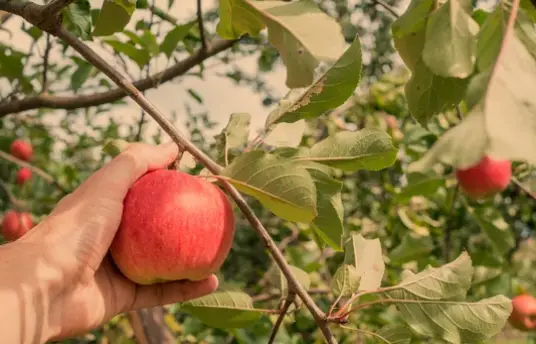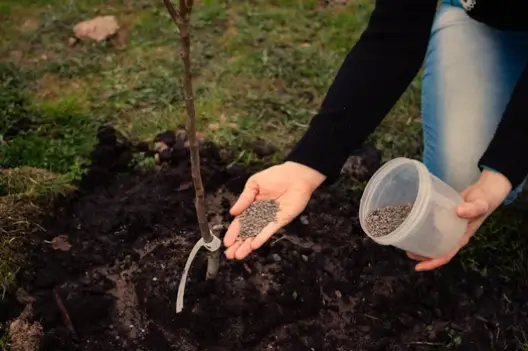Apple trees are a valued addition to many gardens and orchards because of their colorful foliage and delectable fruit.
But, proper care and upkeep are necessary to make sure that your apple trees grow and yield a plentiful fruit. Fertilization is a critical component of apple tree maintenance.
Apple trees are given the nutrients they require to develop quickly, bloom profusely, and produce high-quality fruit through fertilization.
This thorough guide will cover all you need to know about fertilizing apple trees, from knowing what the plants’ nutritional needs are to picking the best fertilizers and methods for application.
It’s important to comprehend the dietary needs of these fruit-bearing trees before getting into the mechanics of fertilizing apple plants.
Like other plants, apple trees need a number of crucial nutrients for optimum growth and fruit production.
Both macronutrients and micronutrients belong to this group of nutrients.
Macronutrients are the primary nutrients that apple trees need in relatively large quantities:
a. Nitrogen (N): Nitrogen is vital for overall tree growth and the production of leaves, stems, and branches. b. Phosphorus (P): Phosphorus supports root development, flowering, and fruit set. c. Potassium (K): Potassium is essential for fruit quality, disease resistance, and water regulation within the tree.
Micronutrients are equally important but are required in smaller amounts:
a. Iron (Fe): Iron aids in the production of chlorophyll and overall plant health. b. Zinc (Zn): Zinc plays a role in various metabolic processes and enzyme function. c. Boron (B): Boron is crucial for flower development, fruit set, and calcium uptake. d. Manganese (Mn): Manganese assists in photosynthesis and enzyme activation. e. Copper (Cu): Copper is involved in several enzymatic reactions within the tree.
Types of Fertilizers for Apple Trees

For your apple trees to be healthy and productive, you must use the correct kind of fertilizer. Fertilizers are normally divided into two groups: synthetic and organic.
Organic Fertilizers: These are derived from natural sources and provide a slow-release of nutrients. Some common organic fertilizers suitable for apple trees include:
a. Compost: Rich in organic matter, compost improves soil structure and fertility. b. Manure: Well-rotted manure adds nutrients and enhances soil quality. c. Bone Meal: High in phosphorus, bone meal is excellent for root development and flowering. d. Fish Meal: A source of nitrogen and micronutrients, fish meal benefits overall tree health.
Synthetic Fertilizers: These are manufactured products with specific nutrient ratios. Synthetic fertilizers are typically available in granular or liquid forms and provide quick nutrient uptake. Key synthetic fertilizers for apple trees include:
a. 10-10-10 NPK Fertilizer: This balanced fertilizer contains equal parts nitrogen, phosphorus, and potassium, suitable for overall tree health. b. 15-15-15 NPK Fertilizer: Similar to the 10-10-10 blend but with higher nutrient concentrations. c. Urea: A high-nitrogen fertilizer that promotes leafy growth.
The choice between organic and synthetic fertilizers often depends on personal preferences, environmental considerations, and the specific needs of your apple trees. Many gardeners prefer a combination of both to capitalize on the benefits of each.
When to Fertilize Apple Trees

Timing is crucial when it comes to fertilizing apple trees. Properly timed applications ensure that nutrients are available when the tree needs them most. The timing of fertilizer applications can be broken down into several key phases:
Early Spring: This is the primary time for apple tree fertilization. Apply fertilizer just before bud break, which typically occurs in late winter to early spring. This early application provides the tree with essential nutrients for leaf development and flower formation.
Late Spring: A second application of fertilizer can be made in late spring, usually around May or early June. This helps maintain nutrient availability as the tree enters the critical fruit development stage.
Early Summer: Some gardeners opt for a light application of nitrogen-rich fertilizer in early summer to support continued growth and fruit development.
Fall: Avoid fertilizing apple trees in late summer or early fall, as this can encourage late-season growth that may not have time to harden before winter. Late-season growth is more susceptible to frost damage.
How to Fertilize Apple Trees

Apple Tree Fertilization
To ensure that apple trees receive the nutrients they need without becoming overloaded, fertilizer must be applied correctly. An explanation of how to fertilize apple trees is provided below:
Step 1: Soil Test: Before applying any fertilizer, conduct a soil test to determine the current nutrient levels in your soil. This will help you make informed decisions about which nutrients your apple trees need.
Step 2: Calculate Fertilizer Amount: Based on the soil test results and the specific nutritional requirements of your apple trees, calculate the amount of fertilizer needed. Follow the manufacturer’s recommendations for the selected fertilizer type.
Step 3: Spread Fertilizer: Spread the calculated amount of fertilizer evenly around the base of the tree, avoiding direct contact with the trunk. The fertilizer should be applied within the dripline, which is the area directly below the outermost branches.
Step 4: Incorporate Fertilizer: After spreading the fertilizer, lightly incorporate it into the soil by raking or hoeing. Be careful not to damage the tree’s roots in the process.
Step 5: Water Thoroughly: Water the area thoroughly to help the fertilizer dissolve and move into the root zone. Adequate watering is essential to ensure that the nutrients are available to the tree’s roots.
Step 6: Mulch: Apply a layer of mulch around the base of the tree to help retain moisture and prevent weeds. Mulch also aids in maintaining a consistent soil temperature.
Step 7: Monitor Growth: Keep a close eye on the tree’s growth and appearance throughout the growing season. Adjust your fertilization regimen as needed based on visual cues and soil tests.
Signs of Nutrient Deficiencies
For prompt management, it is critical to identify the symptoms of nutritional deficits in your apple trees. Here are a few typical signs of nutritional deficiency:
Nitrogen Deficiency:
- Pale green or yellow leaves.
- Reduced growth and small leaves.
- Early leaf drop.
Phosphorus Deficiency:
- Dark green leaves with purplish or reddish discoloration.
- Stunted growth.
- Delayed fruit production.
Potassium Deficiency:
- Yellowing or browning of leaf margins.
- Reduced fruit quality.
- Susceptibility to diseases and pests.
Iron Deficiency:
- Yellowing between leaf veins, known as interveinal chlorosis.
- Reduced fruit production.
Zinc Deficiency:
- Smaller leaves with distorted or narrow shapes.
- Poor fruit set.
- Shortened internodes (the space between leaves or buds on a stem).
Boron Deficiency:
- Flower and fruit drop.
- Corky or cracked fruit.
- Short, stubby shoots.
Manganese Deficiency:
- Light green to yellow leaves with mottled appearance.
- Reduced fruit production.
Copper Deficiency:
- Dieback of branch tips.
- Reduced fruit production.
If you suspect a nutrient deficiency in your apple trees, it’s essential to identify the specific nutrient lacking and address it promptly through the appropriate fertilizer or soil amendment.
Common Mistakes to Avoid

When it comes to apple tree fertilization, there are some common mistakes that gardeners should avoid to ensure the health and productivity of their trees:
Overfertilization: Applying too much fertilizer can lead to nutrient imbalances, root damage, and even tree stress. Always follow recommended application rates.
Underfertilization: Conversely, failing to provide adequate nutrients can result in poor growth and low fruit production. Regular soil testing can help determine the tree’s nutrient needs.
Fertilizing too late in the season: Avoid late-season fertilization, as it can promote late growth that is vulnerable to frost damage.
Neglecting soil health: Healthy soil is the foundation for healthy apple trees. Focus on improving soil quality through practices like mulching, composting, and proper watering.
Using the wrong fertilizer: Not all fertilizers are suitable for apple trees. Be sure to choose a fertilizer with the appropriate nutrient balance for your specific tree’s needs.
Ignoring environmental factors: Consider local climate, soil type, and tree variety when developing a fertilization plan. What works for one apple tree may not be suitable for another.
Conclusion
A key component of home gardening and orchard management is fertilizing apple trees. You may ensure the health, vitality, and productivity of your cherished fruit-bearing trees by being aware of their nutritional requirements, choosing the appropriate fertilizers, and using the right application methods.
Every apple tree is different, therefore it’s important to monitor their development and modify your fertilizer schedule as necessary. Your apple trees will provide you with delicious, crisp fruit year after year if you give them the proper care and attention, transforming your garden or orchard into a place of abundance and beauty.
Source
Here are some reputable sources you can consult for more information on apple tree fertilization:
- University of California Agriculture and Natural Resources – “Fertilizing Your Backyard Fruit Trees”: Website: https://ucanr.edu/sites/WREC/files/294416.pdf
- University of Minnesota Extension – “Growing Apples in the Home Garden”: Website: https://extension.umn.edu/fruit/growing-apples-home-garden
- University of Georgia Cooperative Extension – “Apple Culture in Georgia”: Website: https://extension.uga.edu/publications/detail.html?number=B740
- The Ohio State University Extension – “Apple Tree Nutrition and Fertilization”: Website: https://ohioline.osu.edu/factsheet/hyg-1429



